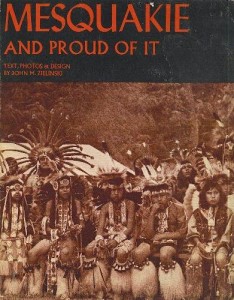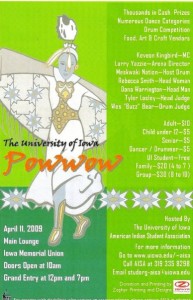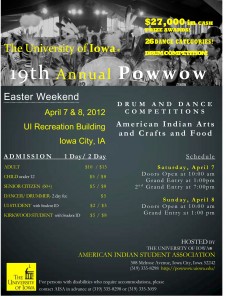The Powwow Then and Now
By the 1960s, American Indians were using the so-called “powwow circuit” – a network of dance competitions held near Native population centers across the U.S. – to socialize and revitalize their cultures. Eastern Iowa also hosted Indian dancing events. In dated language, Laurence Lafore mentioned it in the October 1971 issue of Harper’s Magazine.
“The surviving red men of the Mesquakie tribe are said to be degraded and oppressed, although the Tama Pow-Wow is a celebrated and good-natured show, and at the approach to Sac City there is a large billboard announcing “Welcome to the home of friendly Indians. You’ll like them without reservations”.”

The Meskwaki are proud that they got some of their territory back not through the grace of the U.S. government, but through their own peaceful efforts: they bought their old lands back from white settlers in Tama, Iowa. Thus they made Tama a settlement, and not a reservation. The billboard’s phrasing not only advertised the powwow, but it also expressed Native resistance to oppressive U.S. Indian policy with subtle humor.
This year’s Meskwaki powwow will be held in Tama between August 9 and 12, 2012. For details, please see the powwow website at http://www.meskwakipowwow.com/
Are you going to attend the University of Iowa Powwow this weekend (April 7-8)? Have you ever wondered about the origins of the event? This June, Special Collections and University Archives will be presenting an exhibit on the popular history of American Indian dancing from our collections. Here is a preview that can help you understand what goes on at the powwow.

The Powwow as Cultural Revival
Even as white Americans appropriated some of their culture to define Americanness, Indians never stopped using music and dancing for their own purposes. Having moved to the big cities on the U.S. government’s post-World War Two relocation programs, many Native Americans reached back to their tribal cultures for spiritual sustenance and dignity in the face of prejudice and poverty. By the 1960s, American Indians were using the so-called “powwow circuit” – a network of dance competitions held near Native population centers across the U.S. – to socialize and revitalize their cultures.
Student lobbying for more ethnic inclusion and cultural diversity on The University of Iowa campus led to the 1971 creation of the Chicano and Indian American Cultural Center, the predecessor of today’s Latino and Native American Cultural Center. The UI’s American Indian Student Association (AISA) became a separate entity in 1990. In addition to organizing conferences, service learning projects and outreach, the Center and AISA have been greatly enriching our communities with the annual University of Iowa Powwow ever since.

The powwow is an opportunity for all to respectfully share and support Native American cultures. The event has a well-defined structure and a program. It is usually held in a large hall with the dance arena in the center, with places for the drum groups, and surrounded by sections designated for resting dancers and their relatives, and the audience. Along the inner walls of the hall are the booths of arts and crafts vendors, as well as stands that sell Native American foods such as fry bread.
There is a protocol all must follow to make the event enjoyable and respectful. The program usually opens with an invocation or prayer ceremony. The opening event is almost always the marching in of veterans of U.S. wars with the country’s colors, stepping to a song that honors their military service. The subsequent dances have a strict order, and they are announced by the master of ceremony, a position of honor in Native America. Various dances for each sex include traditional style, jingle, and fancy dancing, and they differ in footwork, regalia, posture, and meaning. Often dancers perform their own story. Their regalia are the result of years of hard work, monetary investment, and meaningful gifts. Judges evaluate the dancers in each category, but also the drum groups and singers, who come from many corners of Native America. Besides the cash prize, winning a powwow category honors the dancer or musician, and furthers their own and their family’s reputation across Native communities.

The American Indian powwow is a combination of a variety of cultural forms. Some of its most prominent dance forms like the Omaha or the Grass Dance are derived from the old warrior society dances that Karl Bodmer and George Catlin recorded in their paintings back in the 1830s. Another origin of the modern powwow are the Old Glory Blowout gatherings held by Buffalo Bill in the 1880s near Indian reservations as auditions for the rodeos, dancing and re-enactment performances of his Wild West Show. These events encouraged inter-tribal interaction and cultural exchange, and led to more frequent gatherings with participants from a variety of Native nations. Community dancing also expressed resistance to white domination when the government’s officials were suspicious of or tried to suppress dancing on reservations. Since the mid-20th century, powwows have also featured honoring dances for Native American veterans of the U.S. military – which makes them events of veterans homecoming. When you experience a powwow, you can ‘read’ the event for traces of this rich history of Native-white relations.
Please mark your calendars and visit the UI Powwow website here: http://powwow.uiowa.edu/
The American Indian Student Association welcomes donations to offset the costs of staging the powwow in our community. AISA accept checks sent to their address at
The American Indian Student Association, The University of Iowa, 308 Melrose Avenue, Iowa City, Iowa 52246 Fax: 319-335-2245 Email: studorg-aisa@uiowa.edu
